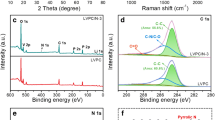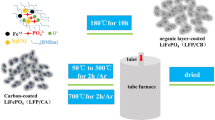Abstract
The poor electronic conductivity and low lithium-ion diffusion are the two major obstacles to the largely commercial application of LiFePO4 cathode material in power batteries. In order to improve the defects of LiFePO4, a novel carbon source polyacrylonitrile (PAN), which would form the hierarchical porous structure after carbonization, is fabricated and used. This work comes up with a simple and facile carbothermal reduction method to prepare porous-carbon-coated LiFePO4 (C-LiFePO4-PC) composite and to study the effect of carbon-coated temperature on ameliorating the electrochemical performance. The obtained C-LiFePO4-PC composite shows a high initial discharge capacity of 164.1 mA h g−1 at 0.1 C and good cycling stability as well as excellent rate capacity (49.0 mA h g−1 at 50 C). The most possible factors that improve the electrochemical performance could be related to the enhancement of electronic conductivity and the existence of porous carbon layers. In a word, the C-LiFePO4-PC material would become an excellent candidate for application in the fields of lithium-ion batteries.







Similar content being viewed by others
References
Winter M, Besenhard JO, Spahr ME, Novak P (1998) Insertion electrode materials for rechargeable lithium batteries. Adv Mater 10:725–763
Liu C, Li F, Ma LP, Cheng HM (2010) Advanced materials for energy storage. Adv Mater 22:E28–E62
Guo YG, Hu JS, Wan LJ (2008) Nanostructured materials for electrochemical energy conversion and storage devices. Adv Mater 20:2878–2887
Gong ZL, Yang Y (2011) Recent advances in the research of polyanion-type cathode materials for Li-ion batteries. Energy Environ Sci 4:3223–3242
Reimers JN, Dahn JR (1992) Electrochemical and in situ x-ray diffraction studies of lithium intercalation in LixCoO2. J Electrochem Soc 139:2091–2097
Ohzuku T, Ueda A (1994) Solid-state redox reactions of LiCoO2 (R3̅m) for 4 volt secondary lithium cells. J Electrochem Soc 141:2972–2977
Luo D, Li G, Yu C, Yang SI, Zheng J, Guan X, Li L (2012) Low-concentration donor-doped LiCoO2 as a high performance cathode material for Li-ion batteries to operate between −10.4 and 45.4 °C. J Mater Chem 22:22233–22241
Padhi AK, Nanjundaswamy KS, Goodenough JB (1997) Phospho-olivines as positive-electrode materials for rechargeable lithium batteries. J Electrochem Soc 144:1188–1194
Padhi AK, Nanjundaswamy KS, Masquelier C, Okada S, Goodenough JB (1997) Effect of structure on the Fe3+/Fe2+ redox couple in iron phosphates. J Electronchem Soc 144:1609–1613
Gong CL, Deng FL, Tsui CP, Xue ZG, Ye YS, Tang CY, Zhou XP, Xie XL (2014) PANI–PEG copolymer modified LiFePO4 as a cathode material for high-performance lithium ion batteries. J Mater Chem A 2:19315–19323
Delacourt C, Laffont L, Bouchet R, Wurm C, Leriche JB, Morcrette M, Tarascon JM, Masquelier C (2005) Toward understanding of electrical limitations (Electronic, Ionic) in LiMPO4 (M = Fe, Mn) electrode materials. J Electrochem Soc 152:A913–A921
Whittingham MS (2004) Lithium batteries and cathode materials. Chem Rev. 104:4271–4301
Mosa J, Aparicio M, Duran M, Robert CL, Sanchez C (2014) Nanocrystalline mesoporous LiFePO4 thin-films as cathodes for Li-ion microbatteries. J Mater Chem A 2:3038–3046
Wang G, Liu H, Liu J, Qiao S, Munroe P, Ahn H (2010) Mesoporous LiFePO4/C nanocomposite cathode materials for high power lithium ion batteries with superior performance. Adv Mater 22:4944–4948
Chung SY, Bloking JT, Chiang YM (2002) Electronically conductive phospho-olivines as lithium storage electrodes. Nat Mater 1:123–128
Wang GX, Yang L, Bewlay SL, Chen Y, Liu HK, Kudo T (2005) Electrochemical properties of carbon coated LiFePO4 cathode materials. J Power Sources 146:521–524
Hu YS, Guo YG, Dominko R, Gaberscek M, Jamnik J, Maier J (2007) Improved electrode performance of porous LiFePO4 using RuO2 as an oxidic nanoscale interconnect. Adv Mater 19:1963–1966
Dominko R, Bele M, Gaberscek M, Remskar M, Hanzel D, Goupil JM, Pejovnik SJamnik J (2006) Porous olivine composites synthesized by sol–gel technique. J Power Sources 153:274–280
Wu XL, Jiang LY, Cao FF, Guo YG, Wan LJ (2009) LiFePO4 nanoparticles embedded in a nanoporous carbon matrix: superior cathode material for electrochemical energy-storage devices. Adv Mater 21:2710–2714
Wang GX, Liu H, Liu J, Qiao SZ, Lu GQM, Munroe P, Ahn H (2010) Mesoporous LiFePO4/C nanocomposite cathode materials for high power lithium ion batteries with superior performance. Adv Mater 22:4944–4948
Ni HF, Liu JK, Fan LZ (2013) Carbon-coated LiFePO4–porous carbon composites as cathode materials for lithium ion batteries. Nanoscale 5:2164–2168
Kong LB, Zhang P, Liu MC, Luo YC, Kang L (2012) Fabrication of promising LiFePO4/C composite with a core–shell structure by a moderate in situ carbothermal reduction method. Electrochim Acta 70:19–24
Zaghiba K, Julien C (2005) Structure and electrochemistry of FePO4·2H2O hydrate. J Power Sources 142:279–284
Adelhelm P, Hu YS, Chuenchom L, Antonietti M, Smarsly BM, Maier J (2007) Generation of hierarchical meso- and macroporous carbon from mesophase pitch by spinodal decomposition using polymer templates. Adv Mater 19:4012–4017
Croce F, Epifanio AD, Hassoun J, Deptula A, Olczac T, Scrosati B (2002) A novel concept for the synthesis of an improved LiFePO4 lithium battery cathode. Electrochem Solid-State Lett 5:A47–A50
Park KS, Son JT, Chung HT, Kim SJ, Lee CH, Kang KT, Kim HG (2004) Surface modification by silver coating for improving electrochemical properties of LiFePO4. Solid State Commun 129:311–314
Chung SY, Bloking JT, Chiang YM (2002) Electronically conductive phospho-olivines as lithium storage electrodes. Nat Mater 1:123–128
Wang GX, Yang L, Bewlay SL, Chen Y, Liu HK, Ahn H (2005) Electrochemical properties of carbon coated LiFePO4 cathode materials. J Power Sources 146:521–524
Du J, Kong LB, Liu H, Liu JB, Liu MC, Zhang P, Luo YC, Kang L (2014) Template-free synthesis of porous–LiFePO4/C nanocomposite for high power lithium-ion batteries. Electrochim Acta 123:1–6
Wang JJ, Sun XL (2011) Understanding and recent development of carbon coating on LiFePO4 cathode materials for lithium-ion batteries. Energy Environ Sci 5:5163–5185
Wang YG, Wang YR, Hosono EJ, Wang KX, Zhou HS (2008) The design of a lifepo4/carbon nanocomposite with a core–shell structure and its synthesis by an in situ polymerization restriction method. Angew Chem Int Ed 47:7461–7465
Saravanan KR, Balaya P, Reddy MV, Chowdari BVR, Vittal JJ (2010) Morphology controlled synthesis of LiFePO4/C nanoplates for Li-ion batteries. Energy Environ Sci 3:457–463
Acknowledgments
This work was supported by the National Natural Science Foundation of China (no. 51362018, 21163010) and the Key Project of Chinese Ministry of Education (no. 212183).
Author information
Authors and Affiliations
Corresponding author
Rights and permissions
About this article
Cite this article
Shi, M., Kong, LB., Liu, JB. et al. A novel carbon source coated on C-LiFePO4 as a cathode material for lithium-ion batteries. Ionics 22, 185–192 (2016). https://doi.org/10.1007/s11581-015-1549-1
Received:
Revised:
Accepted:
Published:
Issue Date:
DOI: https://doi.org/10.1007/s11581-015-1549-1




